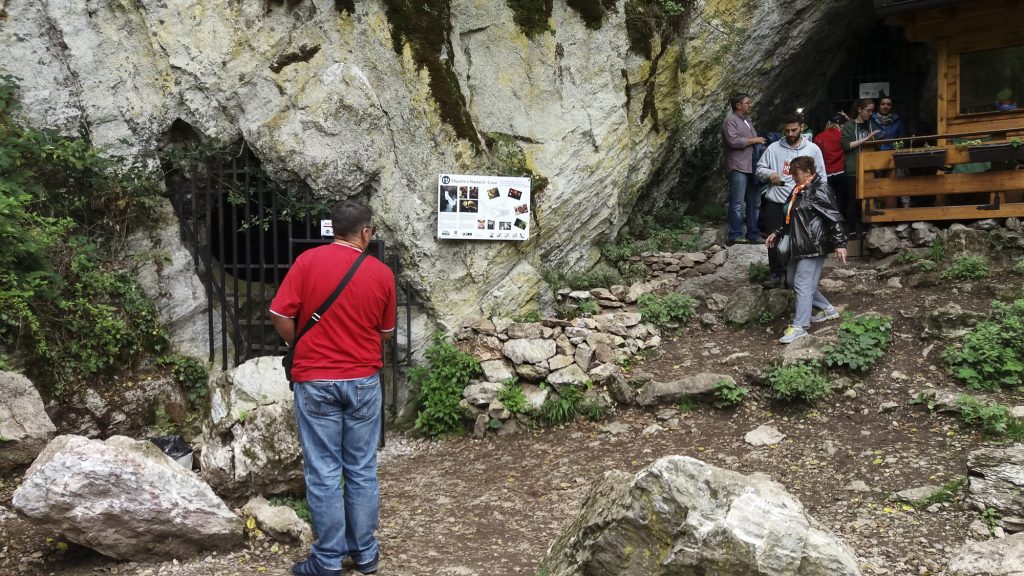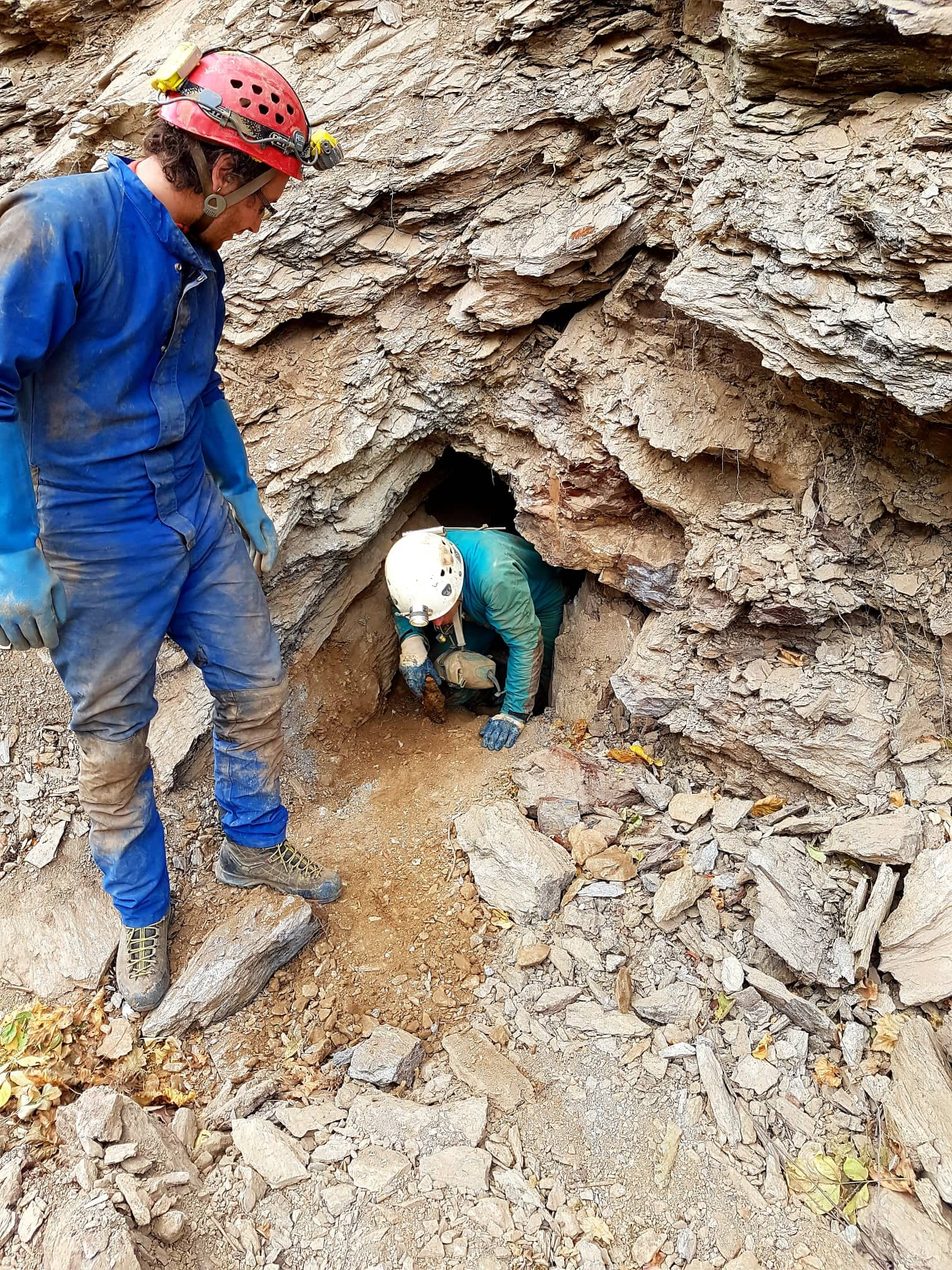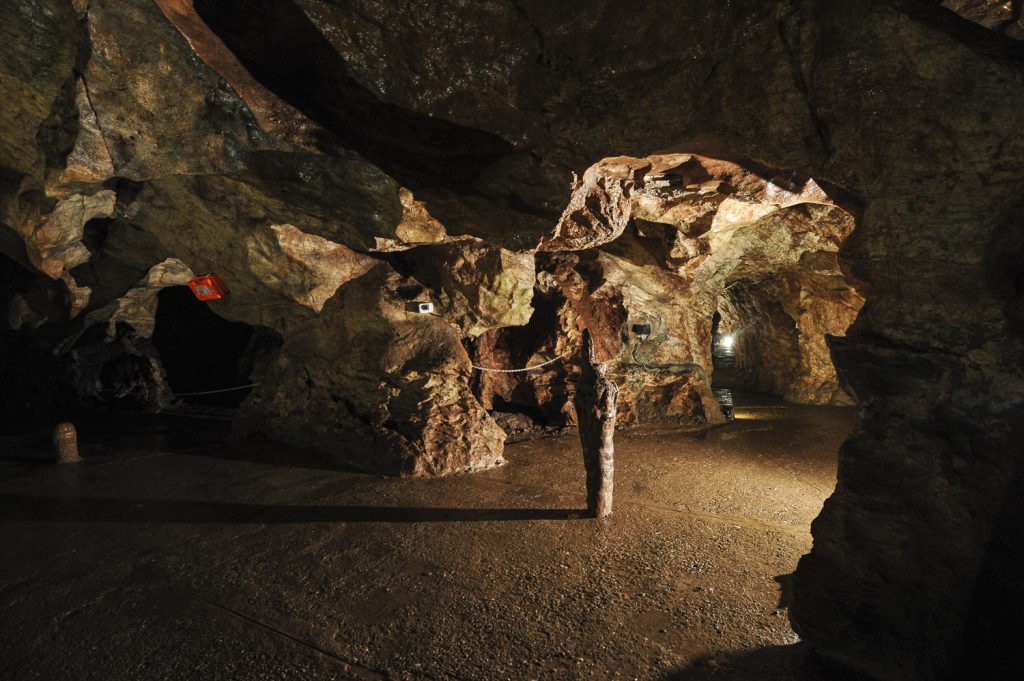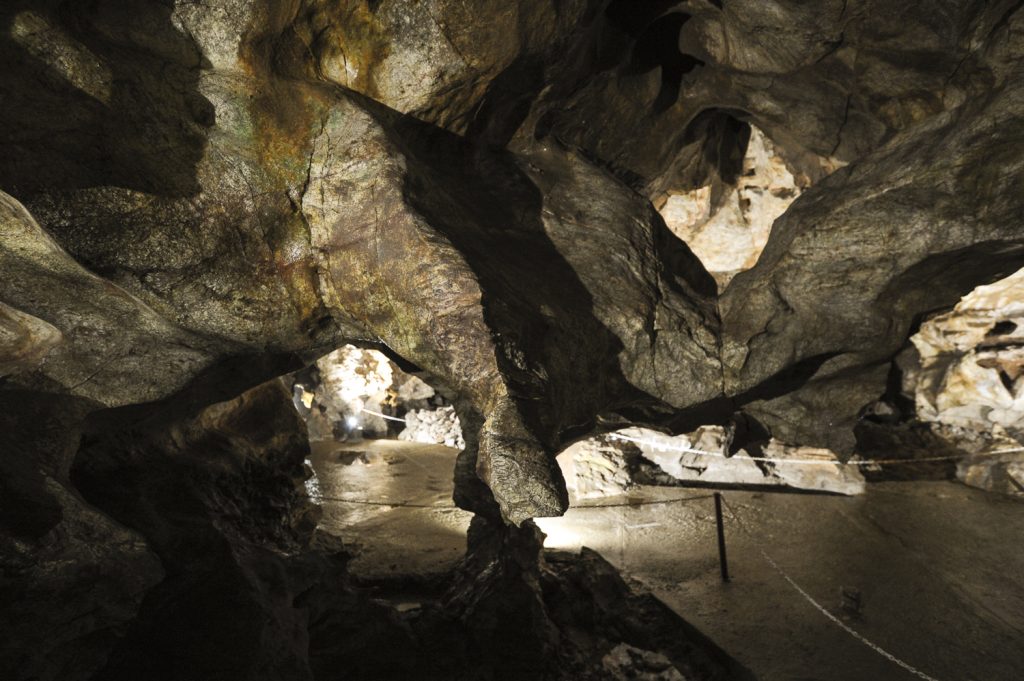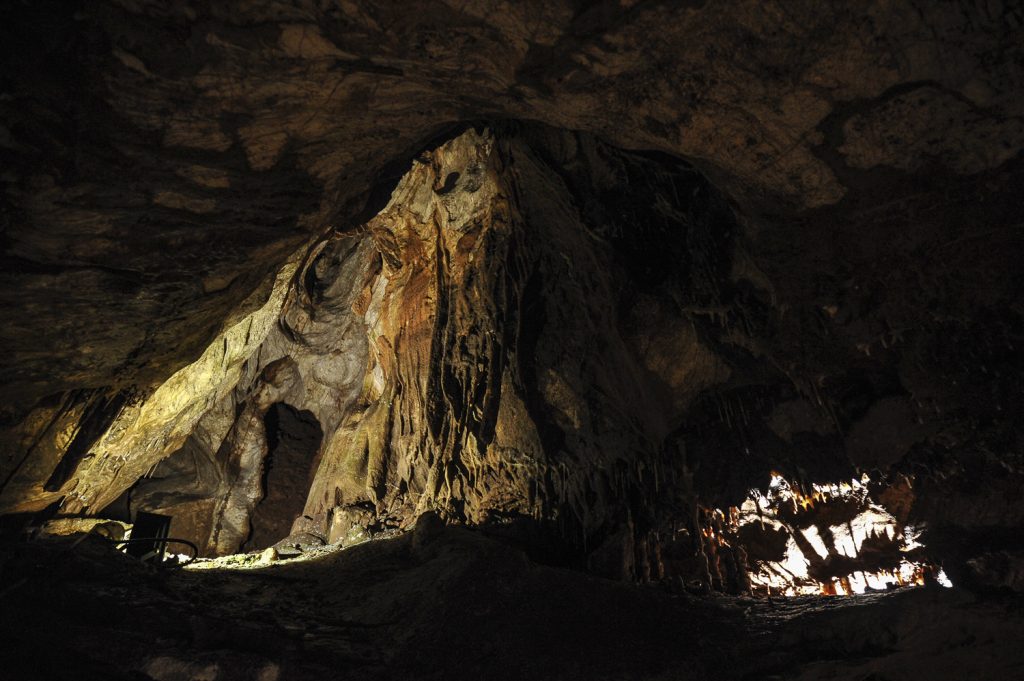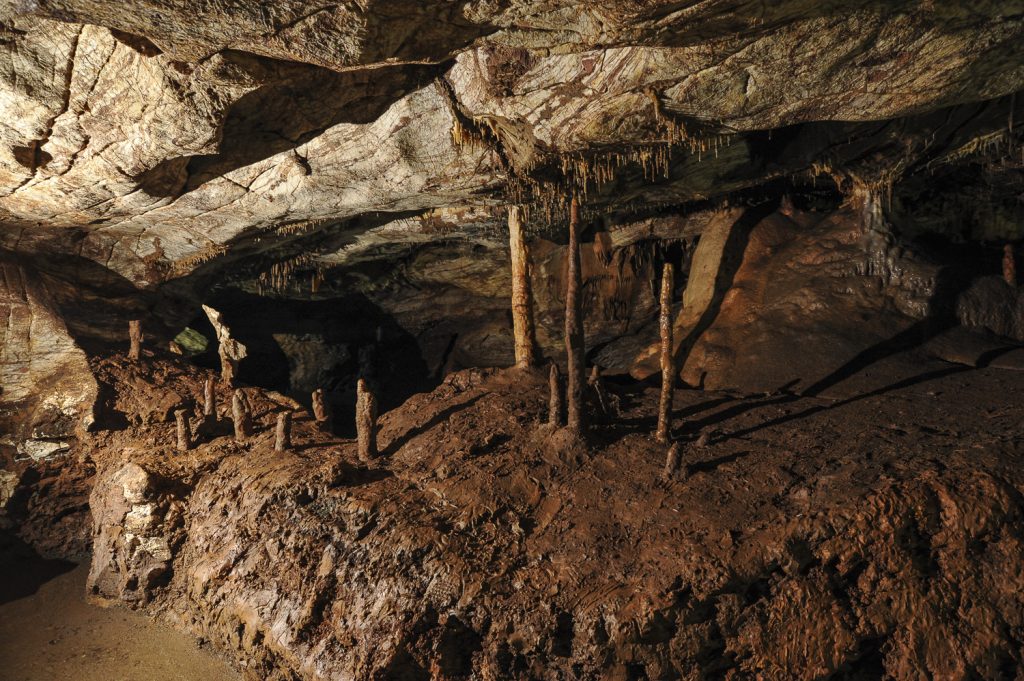Going a little deeper inside two of Kosovo’s most famous touristic caves reveals the drawbacks of institutional takeover and intervention in what are the world’s most idyllic and untouched natural environments.
The Drini i Bardhe spring and waterfalls close to the Radavc village near Peja have been a scenic tourist spot for decades. Trekking past the famous waterfall and up into the forest, a winding path leads you to the mouth of a cave.
Small and unassuming, this is the entrance to a complex web of tunnels, corridors and galleries, some yet to be discovered, shaped by the force of around two million years of rainfall soaked in from the mountains of Rugova.
Drive about an hour to the east of the Radavc cave, 10 km from Prishtina, and you find the village of Gadime, home to the Marble Cave, as it is popularly known. The cave allegedly hosts around 70 thousand visitors per year, said the cave’s tour guides, many of them school students who come to see the cave’s rare marble interior and the unusual crystals that grow within it.
But as you approach the entrance, the difference between Radavc’s scenic surroundings and Gadime’s is striking.
The mouth of the Marble Cave in Gadime is nowhere to be seen. Beside the small ticket booth and a large restaurant, a huge stone structure and a glass door have been built in its place, like the entranceway to a court building or a shopping mall. Unable to view the natural surroundings of the cave, concrete is plastered across the entrance floor, and 400 meters deep into the cave itself.
While the cave at Radavc is alive and bursting with activity, with explorers, archaeologists, biologists and cave divers unearthing the secrets of two million years of natural history, Gadime is being left behind. Under protection from the Kosovo government since 2011 as a natural monument of “special importance,” Gadime’s exploration has been stunted by lack of management and funding, allegations of corruption, and careless treatment of the cave’s natural environment.
A haven for Kosovo’s flora and fauna
Fatos Katallozi is the President of the Speleology Federation of Kosovo, an association of Kosovo cave explorers, and the official manager of the cave in Radavc. Hopping over the metal rail he built inside the cave, stopping tourists falling 90 meters to the maze of underground rivers below their feet, he explained how he began protecting the Radavc cave and opening it for tourism.
“We’ve explored Radavc since 2002, and even before that we used to go to the cave, but we didn’t have the gear to satisfy our curiosities,” said Katallozi as he maneuvered himself easily across the slippery limestone. “An Italian group of caving and rock climbing professionals came and trained us for about two weeks, they left us some second hand gear so we could keep exploring.”
In 2005, Katallozi registered his speleology association officially, naming it ‘Aragonit’ after crystals that form in limestone, the rock that the Radavc cave is made from. By 2015, after spending so much time exploring Radavc, he took over management of the cave, and renamed it ‘Sleeping Beauty.’
“If they found out how many visitors we get to Radavc, they might take it away from me,” he said, laughing, instead of divulging the number of tourists flocking to the cave each year.
With just a helmet, headlamp and gloves, Katallozi descended towards one of the underground rivers. After a slow climb down, the cave opens up into a gallery with a sandy underground beach, littered with stalactites, icicle-like rock formations shaped by water dripping from the cave’s ceiling, broken off by the villagers who explored the cave before it became a protected area.
“We didn’t want to intervene with the walls of the cave, we washed away graffiti left by the villagers, put up a gate and made some small improvements,” he explained, pointing to the remnants of gold paint sprayed on the walls. “We built the metal stairs so that it would be easier for tourists to visit safely without knocking any of the cave away, we didn’t use any cement at all.”
The second biggest cave in Kosovo after the cave of the Rugova Grand Canyon, Radavc so far spans 3,860 meters into the mountain. Katallozi’s most important project has been the digital mapping of the cave’s interior, and over the last 12 years, he and his team have more than doubled the length of the cave that has been discovered.
Many of these galleries are home to bats, blind cave crickets, and foxes lured in by the prospect of an easy lunch and get lost in the darkness. Even today, biologists are still discovering new species that thrive there, said Katallozi.
Radavc is only one of eight caves that can be found in the Peja region, and was first explored by a team from Novi Sad led by Jovan Petrovic, in 1968, around the same that Gadime was discovered.
Unlike Radavc, Katallozi explained, Gadime is relatively flat, making it easier for tourists to visit. This and its proximity to Prishtina are the main reasons it was chosen to be a protected area in 1969 and opened for tourists by the former Yugoslav government in the 1970s, he said.
Squeezing nature into a historical narrative
As he wandered through the galleries in Gadime, Januz Ejupi, a guide at the Marble Cave, explained that an entranceway to the cave was discovered in 1969 when a villager, Ahmet Asllani, was digging the foundations to build his own house, and knocked through the earth to find it underneath his land.
Gadime was opened for tourists in 1974, with the biggest gallery in the cave used for acoustic concerts and shooting films. Most striking are the shining crystals formed from the limestone on the cave walls, a rare and beautiful characteristic of the 1,200 meters of the cave discovered so far.
“The stalactites and stalagmites create the crystals. These kind of crystals bend the laws of physics and gravity, the water doesn’t drip down but it spreads across the walls in the caves,” said Ejupi, explaining how the shape of the cave is formed. “This is particularly special because the crystal doesn’t exist anywhere else in Europe.”
Growing from the floor near the ‘concert hall’ gallery is a large cluster of stalagmites in the shape of a hand. Two stalagmites at one point would have stood above the others like fingers pointing upwards, but one ‘finger’ has since been broken off.
“It had two fingers but during the war it was destroyed, they broke off one of the fingers. They say that if the statue had had 3 fingers they would not have destroyed it at all. It’s called the Victory statue,” said Janjupi.
The three-finger gesture, commonly made by Serbians and ethnic Serbs by extending the thumb, index and middle finger of one hand, leaving the ring and little fingers curled to the palm, was originally symbolized the Holy Trinity of Serbian Orthodoxy, and has since become a sign made in affiliation with Serbian nationalism.
Other than the ‘Victory Statue,’ Gadime also boasts Skenderbeg’s Beard, an eagle, a rock shaped like the map of Kosovo and more, with historical sentiment playing a key role in the bulk of the narratives of the Gadime tour guides.
This is not the only kind of story spun at the Marble Cave – the tour culminates with a visit to the last gallery open to visitors, named the Garden of Love. There you can find Romeo and Juliet, a stalagmite and stalactite that have grown and will eventually conjoin, turning into a pillar.
“It will take one and a half thousand years for them to get together,” said Ejupi. “You’re invited to the wedding, but I’m not sure that you’ll be around for it!”
Those who have visited the cave say that these narratives have remained unchanged for more than a decade.
Gadime is full of these unique geological features, but it can be difficult to shake off the uneasy feeling that that it has been meddled with. From the concrete flooring and electrical wires visible through the cave’s interior to attributing artificial historical significance to its geological features, the human imposition that the cave has been subject to is tangible.
Rock formations in caves are like natural sculptures, and in Radavc, these features seem to have been faithfully preserved: tourists are guests in what is an otherwise natural space that belongs to the life forms residing there, and guides through Radavc leave space for creativity.
“These caves have beautiful formations, and they can be anything you want,” said Katallozi, as we approach an archway in the rock resembling an elephant, walking underneath the gap between its legs and further into the cave. “I prefer to let the visitors interpret what they see [in the rock formations], to try and trigger their imagination.”
Katallozi pointed to a sharp upward rift in the rock face that curves round for two meters like a large animal’s spine, curling into a tail at one end, and a jagged snout and eyes at the other.
“I like to say it’s a dragon,” said Katallozi. “If you look at the rock that its snout is facing, you see two large holes that have been bored into the wall of the cave, as if the dragon has breathed fire from its nostrils.”
Through the Speleology Federation and Katallozi’s own tourist agency, Outdoor Kosova, Radavc is visited by experts all year round specifically because the cave has been left almost untouched by human hands. So many caves in Europe have been explored and documented already, he said, which is why archaeologists, explorers and biologists have been drawn to Kosovo in the last ten years.
“We make applications to do research with different teams around Europe, we found three new species down here recently with speleobiologists [cave biologists] from Split and Zagreb,” he said, pointing towards the huddles of bats that cling together from the walls of the cave. “We’re doing digital mapping of the cave and more exploring with teams from all over, and then with the Polish we are doing cave diving too.”
This kind of collaboration and exploration has not been so easy for the cave in Gadime, however. Ejupi explained that the bulk of the tunnels and underground rivers in the Marble remain undiscovered, and that currently nobody is conducting any kind of exploration activities.
“Here there is a hole which we know it goes 16 kilometers all the way to Janjevo [a village in Lipjan municipality],” he said. “We found out because a stray dog with a rabbit went inside there and came out in Janjevo. Once, we decided to go in and explore with a KFOR soldier, but we only managed to go four kilometers deep, as we don’t have the resources to prepare the tunnel and get the mud out. We need investments, which hasn’t happened yet.”
“Here you can see the lake,” Ejupi said, pointing to a body of water a few hundred meters inside the cave, with a small opening in the cave wall just at the water’s surface. “Once a diver went through there and saw there is three kilometers of water, but this also needs some more investment to break it up so it can be explored properly, and so that the viewers can see the vastness of the lake in its full form.”
Despite Gadime’s status as the only cave ‘of special importance’ in Kosovo, this title has held back its preservation and exploration rather than warranting expert care.
Why has Gadime been pushed aside?
Seven other caves in Kosovo are under the protection of the MESP as ‘nature monuments,’ through the Law on Nature Conservation, but only Gadime was given specific protection as a ‘natural monument of particular importance’ in 2011 in order to improve its management and preserve its natural characteristics.
The 2015 Overview of Nature Protection Progress in Kosovo heralded Gadime’s “degradation, changes of microclimate, damages of crystals, changes in flora species that are characteristic of caves” as some of the consequences of its improper management, and the basis for its designation as a protected area.
The Ministry of Environment and Spatial Planning, MESP’s 2014 State of Nature Report explained that lack of infrastructure, investment, plans and concrete projects have prohibited the development of the caves’ capacity as an ecotourism hotspot.
“A special problem is the approach of governmental institutions and Kosovo society has towards sustainable exploitation of this potential,” the report reads. “Uncontrolled exploitation of natural resources, damage to ecosystems, illegal hunting and expansion of settlements are constant threat for these values.”
In 2013 the MESP closed and temporarily banned all activities in Gadime, the report says, believing the cave to be under threat from illegal activities that put its characteristics and value at risk.
In the same year, the Board of the Privatization Agency of Kosovo in 2013 transferred the cave to be under the administration of the MESP, hiring a supervisor, guides and security, opening the cave for visitors in May 2014.
The 2014 State of Nature report highlighted the inadequate lighting in the cave as a problem, which poses a risk the security of the visitors and has resulted in unwelcome changes in the cave’s microclimate.
The same year, the French Embassy in Kosovo allocated 11 thousand euros to improve the interior lighting of the Gadime cave. However, this remains a problem for the aesthetic value of the cave, according to Ejupi.
“When it’s designed with proper light, every crystal has its own beauty,” said Ejupi. “The lights should be set up better so that every position of the light will give a different effect to the stalactites and the crystals.”
Earlier this year, five of the Gadime cave employees, including Ejupi, penned a letter to newspaper Gazeta Express, the MESP and the Kosovo Environmental Protection Agency, KEPA, with allegations of extortion and misuse of official duty by two of their colleagues, who had allegedly been “misused a minimum of 200 euros a day, while during the dismissal of the finance officer they misused about 700 euros a day.”
The MESP’s 2022 Environment Strategy objectives involve strengthening the management authorities for protected areas. Gadime in particular is mentioned as a site where development is needed in terms of tourism capacity, monitoring and scientific research, the strategy stating that “the capacities have not reached a satisfactory level at the moment to make this sustainable.”
Providing support to ecotourism initiatives in the private sector is listed as a key objective for developing Kosovo’s natural and cultural heritage sites, a model that has worked successfully for Radavc, Katallozi said, and one that can help other natural sites in Kosovo to flourish.
“We’ve explored, we’ve done so much marketing, we’ve been to international tourist fairs, and now, the results are coming.”






